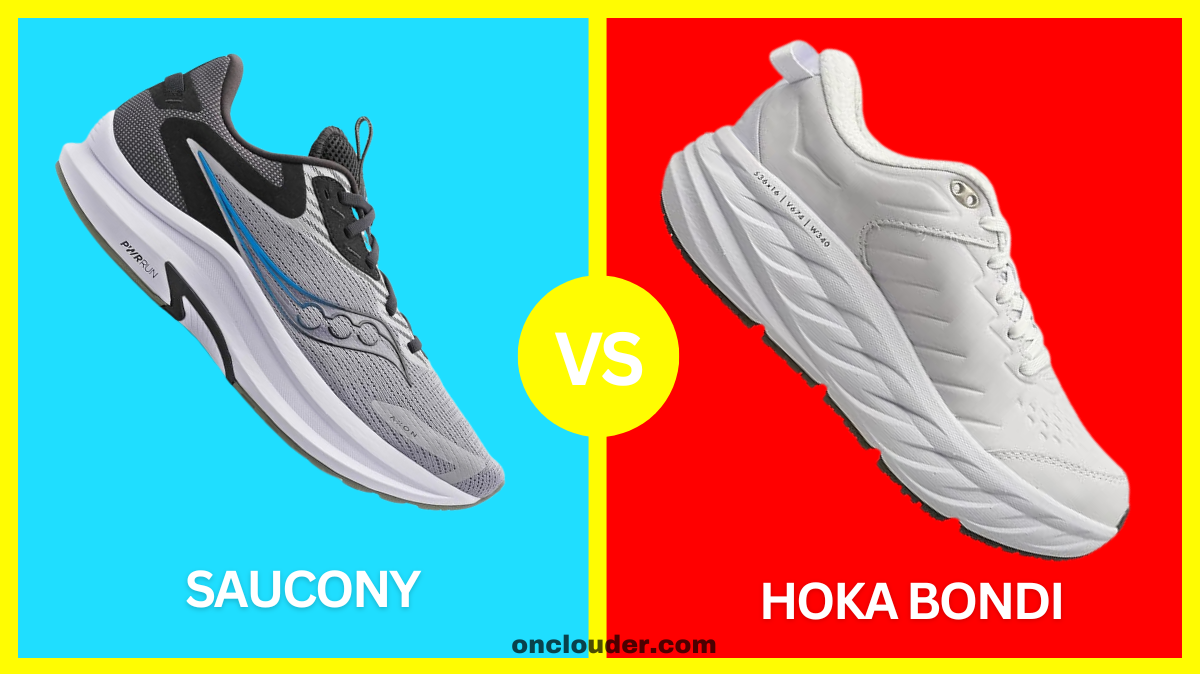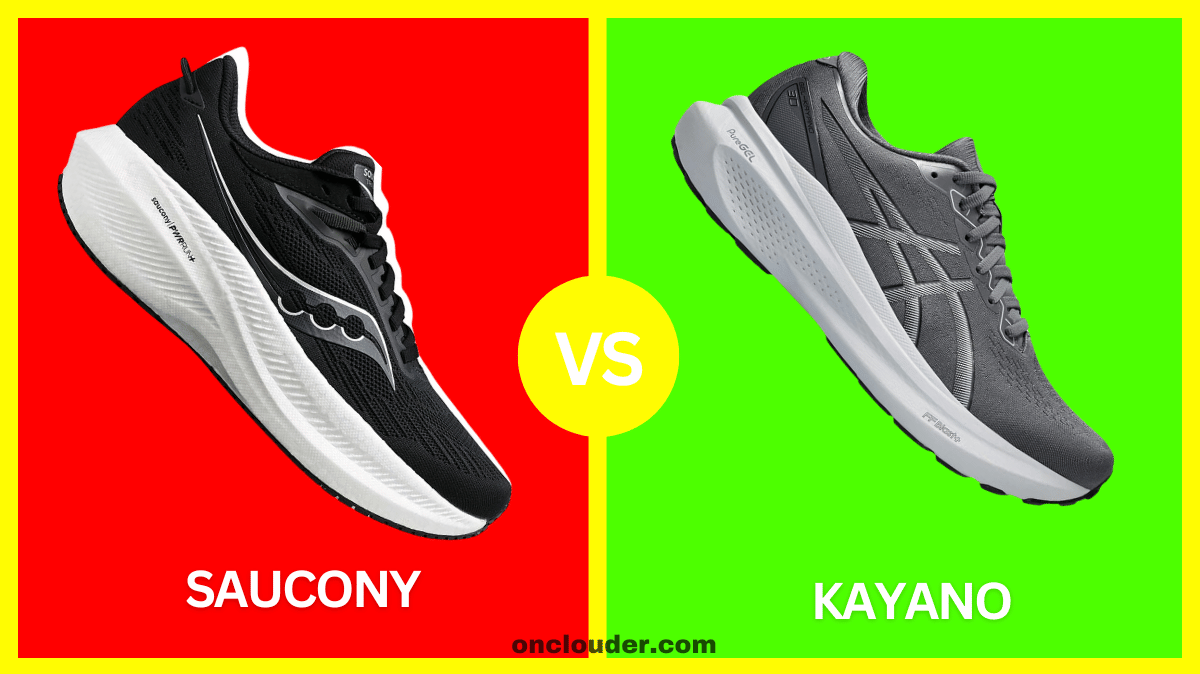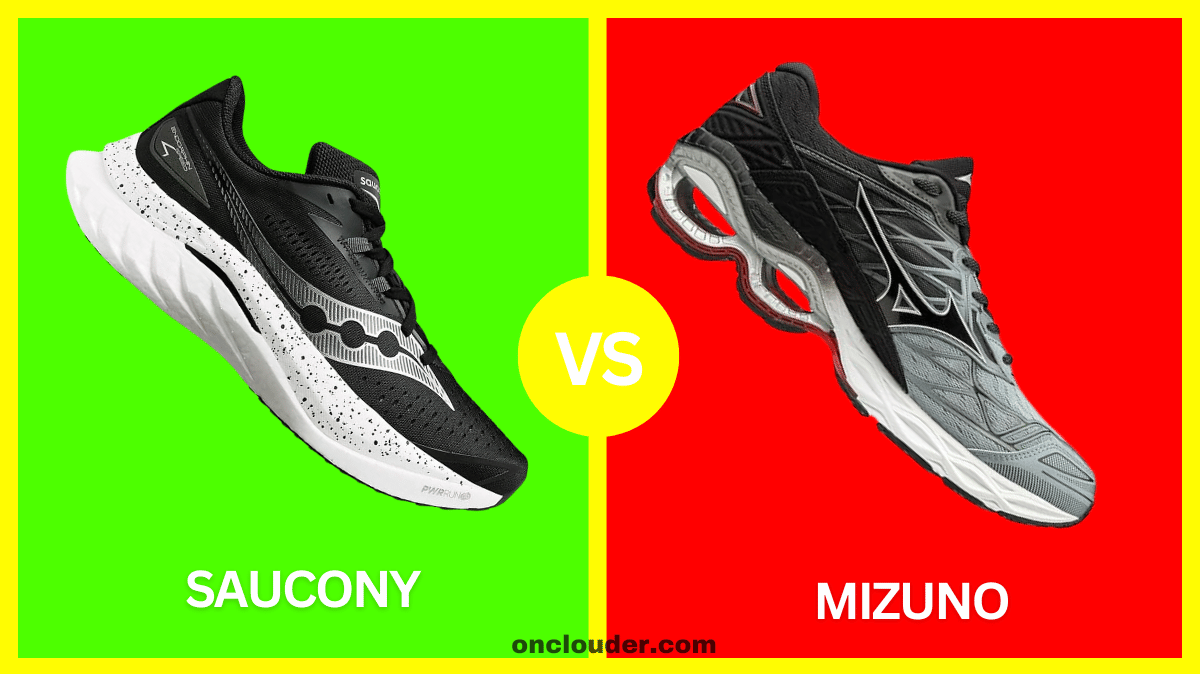Are you looking for the perfect pair of shoes to keep your feet happy during your next adventure?
Well, you’re in luck! Today, we’re going to compare two popular shoe brands: Saucony and Hoka Bondi.
By the end of this article, you’ll know exactly which one might be the best fit for you.
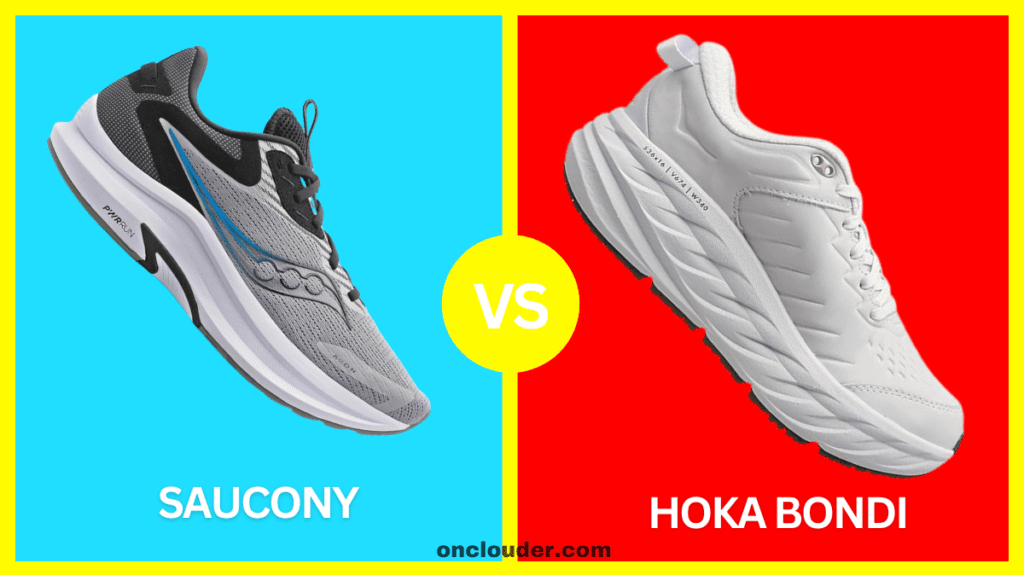
Contents
- 1 Quick Comparison: Saucony vs Hoka Bondi Shoes
- 2 What Makes These Shoes Special?
- 3 Cushioning: The Fluffy Cloud Effect
- 4 Shoe Fit: Finding Your Perfect Match
- 5 Durability: Built to Last
- 6 Breathability: Keeping Your Feet Cool
- 7 Stability: Keeping You Steady
- 8 Quality: The Good Stuff
- 9 Style: Looking Good While Feeling Good
- 10 Size and Fit: Getting It Just Right
- 11 Materials: What Are These Shoes Made Of?
- 12 Weight: Light as a Feather or Sturdy and Strong?
- 13 Flexibility: Bend It Like Beckham
- 14 Water Resistance: Splash Proof?
- 15 Sole: The Foundation of Your Shoe
- 16 User Reviews: What Do Other Kids Think?
- 17 Price: What’s It Going to Cost?
- 18 Conclusion
- 19 Frequently Asked Questions
Quick Comparison: Saucony vs Hoka Bondi Shoes
The main difference between Saucony and Hoka Bondi shoes lies in their cushioning and design philosophy. Saucony offers a more traditional running shoe experience with moderate cushioning and a focus on responsiveness.
In contrast, Hoka Bondi shoes feature maximum cushioning and a unique rocker design for enhanced comfort during long-distance runs.
Now, let’s create a detailed comparison table for “Saucony vs Hoka Bondi Shoes“:
| Feature | Saucony | Hoka Bondi |
| Cushioning | Moderate | Maximum |
| Weight | Generally lighter | Typically heavier |
| Stack height | Lower to moderate | High |
| Heel-to-toe drop | Varies (usually 4-8mm) | Low (typically 4mm) |
| Midsole | PWRRUN or PWRRUN+ foam | EVA foam |
| Upper | Engineered mesh | Engineered mesh |
| Outsole | Rubber with strategic placement | Full-length rubber |
| Stability | Neutral to moderate support | Neutral with inherent stability |
| Price range | $100-$160 | $150-$170 |
| Best for | Speed, responsiveness, versatility | Long-distance comfort, recovery runs |
| Foot type | Narrow to medium | Medium to wide |
| Durability | Good | Excellent |
In summary: Saucony and Hoka Bondi shoes cater to different running preferences. Saucony focuses on providing a balance between cushioning and responsiveness, making them versatile for various running activities.
Hoka Bondi shoes, on the other hand, prioritize maximum cushioning and comfort, making them ideal for long-distance runs and recovery. The choice between the two brands depends on individual running style, foot type, and specific needs.
What Makes These Shoes Special?
Before we dive into the details, let’s talk about why Saucony and Hoka Bondi shoes are so popular. Both brands are known for making comfortable, high-quality running shoes that can handle all sorts of activities.
Whether you’re walking to school, playing sports, or going on a family hike, these shoes have got you covered!
Cushioning: The Fluffy Cloud Effect
When it comes to cushioning, both Saucony and Hoka Bondi shoes are like walking on fluffy clouds. But there’s a difference in how they feel:
Saucony Cushioning
Saucony shoes use special foam that gives you a bouncy feel. It’s like having mini trampolines under your feet! This foam helps absorb the shock when your foot hits the ground, making your steps feel light and springy.
Hoka Bondi Cushioning
Hoka Bondi shoes are famous for their extra-thick soles. They have so much cushioning that some people say it feels like walking on marshmallows! This super-soft feeling can be great if you have sore feet or if you’re going to be on your feet all day.
Shoe Fit: Finding Your Perfect Match
Getting the right fit is super important. It’s like finding the perfect glove for your hand, but for your feet!
Saucony Fit
Saucony shoes often have a wider toe box, which means there’s more room for your toes to wiggle around. This can be great if you have wider feet or if you like a little extra space.
Hoka Bondi Fit
Hoka Bondi shoes usually have a snugger fit, especially around the middle of your foot. Some people love this because it makes them feel secure, like their foot is being hugged by the shoe.
Durability: Built to Last
When you’re picking out shoes, you want them to last a long time, right? Let’s see how Saucony and Hoka Bondi stack up in the durability department.
Saucony Durability
Saucony shoes are known for being tough cookies. They use strong materials that can handle a lot of wear and tear. The soles are made with rubber that grips the ground well and doesn’t wear down too quickly. Many kids find that their Saucony shoes can keep up with them for a whole school year or even longer!
Hoka Bondi Durability
Hoka Bondi shoes are also built to last, but in a different way. Their super-thick soles mean there’s more material between your foot and the ground. This can help the shoes last longer because it takes more time for all that cushioning to wear down. However, because the soles are so soft, they might show signs of wear a bit sooner than Saucony shoes.
Breathability: Keeping Your Feet Cool
Nobody likes sweaty, stinky feet! That’s why it’s important to have shoes that let your feet breathe. Let’s see how our two contenders do in this area.
Saucony Breathability
Saucony uses special fabrics in their shoes that allow air to flow in and out. This helps keep your feet cool and dry, even when you’re running around on a hot day. Some Saucony shoes even have little holes or mesh panels that act like tiny windows for your feet!
Hoka Bondi Breathability
Hoka Bondi shoes also care about keeping your feet fresh. They use lightweight materials that help sweat evaporate quickly. However, because Hoka Bondi shoes have thicker soles, some people find that their feet get a bit warmer in these shoes compared to Saucony.
Stability: Keeping You Steady
When you’re running, jumping, or even just walking, you want shoes that keep you steady on your feet. Both Saucony and Hoka Bondi have some tricks up their sleeves to help with this.
Saucony Stability Features
Saucony shoes often have a firmer piece of foam on the inner side of the sole. This helps prevent your foot from rolling inward too much when you step. They also have a shaped footbed that cradles your foot, giving you a stable feeling.
Hoka Bondi Stability Features
Hoka Bondi shoes take a different approach. Their wide, thick soles create a large base for your foot. This can make you feel more stable, almost like you’re standing on a platform. Some Hoka Bondi models also have a special heel cup that holds your foot in place.
Quality: The Good Stuff
When we talk about quality, we’re looking at how well the shoes are made and what materials they use. Both Saucony and Hoka Bondi are known for making good-quality shoes, but they have different strengths.
Saucony Quality
Saucony has been making shoes for a long time, and they’ve gotten really good at it. They use strong stitching to hold the shoes together and choose materials that can handle lots of activity. Many runners trust Saucony because they know the shoes will hold up well over time.
Hoka Bondi Quality
Hoka Bondi is a bit newer to the shoe game, but they’ve made a big splash with their innovative designs. They focus on using high-tech materials, especially in their soles. The quality of Hoka Bondi shoes is most noticeable in how comfortable they are and how well they absorb shock when you’re running or walking.
Style: Looking Good While Feeling Good
Let’s face it, you want shoes that look cool too! Both Saucony and Hoka Bondi have their own unique styles.
Saucony Style
Saucony shoes often have a classic, sporty look. They come in lots of different colors, from bright and bold to more subtle shades. Many Saucony shoes have a sleek design that looks great whether you’re at school or hanging out with friends.
Hoka Bondi Style
Hoka Bondi shoes have a very distinctive look because of their thick soles. Some people think they look super cool and futuristic, while others might find them a bit unusual at first. Hoka Bondi shoes also come in various colors, and many have fun color combinations that really stand out.
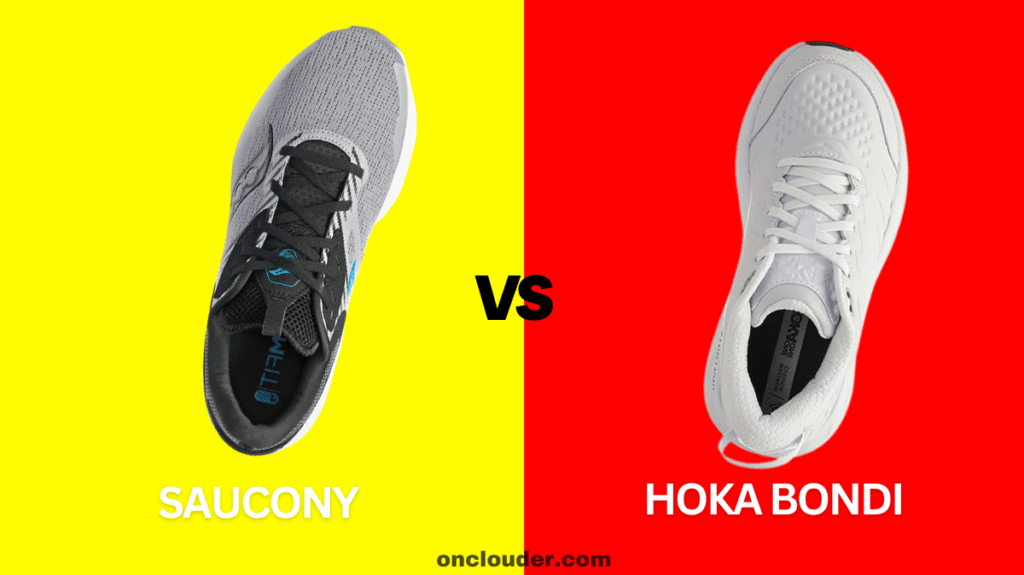
Size and Fit: Getting It Just Right
Finding the right size is super important for any shoe. Let’s look at how Saucony and Hoka Bondi handle sizing.
Saucony Sizing
Saucony shoes usually run true to size, which means the size you normally wear will probably fit well. They offer a good range of sizes, including half sizes, to help you get the perfect fit. Some Saucony models also come in different widths, which is great if you have narrow or wide feet.
Hoka Bondi Sizing
Hoka Bondi shoes can be a bit trickier when it comes to sizing. Some people find that they need to go up a half size in Hoka Bondi shoes because of the snugger fit. Hoka Bondi also offers different widths in some of their models, but not as many as Saucony.
Materials: What Are These Shoes Made Of?
The materials used in your shoes can make a big difference in how they feel and how long they last. Let’s take a closer look at what Saucony and Hoka Bondi use to make their shoes.
Saucony Materials
Saucony uses a mix of synthetic materials and mesh for the upper part of their shoes. This helps make the shoes light and breathable. For the soles, they use special types of rubber and foam that give you a good balance of cushioning and bounce.
Hoka Bondi Materials
Hoka Bondi also uses lightweight, synthetic materials for the upper part of their shoes. But where they really stand out is in their soles. Hoka Bondi uses a special foam that’s super light but also very cushioning. This is how they can make their soles so thick without making the shoes heavy.
Weight: Light as a Feather or Sturdy and Strong?
The weight of your shoes can affect how comfortable they are, especially if you’re wearing them all day or doing a lot of running.
Saucony Weight
Saucony shoes are generally pretty lightweight. They try to find a good balance between having enough cushioning and support while still keeping the shoes light. This makes them a great choice if you do a lot of different activities and want a versatile shoe.
Hoka Bondi Weight
You might think that with their big, thick soles, Hoka Bondi shoes would be heavy. But surprisingly, they’re often not much heavier than other running shoes! Hoka uses super light materials to keep the weight down, even with all that extra cushioning.
Flexibility: Bend It Like Beckham
Flexible shoes can make it easier and more comfortable to walk or run. Let’s see how our two shoe brands compare in this area.
Saucony Flexibility
Saucony shoes are designed to flex with your foot as you move. They have special grooves in the sole that allow the shoe to bend naturally. This can make it feel like the shoe is working with your foot, not against it.
Hoka Bondi Flexibility
Hoka Bondi shoes, with their thicker soles, might seem like they’d be stiff. But they’re actually designed to be pretty flexible too. They have a special rocker shape that helps your foot roll forward smoothly as you walk or run.
Water Resistance: Splash Proof?
While neither Saucony nor Hoka Bondi makes fully waterproof running shoes, they do have some features to help keep your feet dry.
Saucony Water Resistance
Many Saucony shoes have a water-resistant coating on the upper part. This helps repel light rain or splashes. The materials they use also tend to dry quickly if they do get wet.
Hoka Bondi Water Resistance
Hoka Bondi shoes also use materials that don’t soak up water easily. Their thick soles can be an advantage in wet conditions too, as they keep your feet further away from puddles or wet ground.
Sole: The Foundation of Your Shoe
The sole is like the foundation of a house – it’s super important! Let’s look at how Saucony and Hoka Bondi design their soles.
Saucony Soles
Saucony soles are designed to give you a good mix of cushioning and responsiveness. They often use different types of rubber in different parts of the sole. This helps give you good grip and makes the shoes last longer.
Many Saucony shoes also have a special piece in the middle of the sole that helps absorb shock and give you a bouncy feel.
Hoka Bondi Soles
Hoka Bondi soles are what make these shoes really stand out. They’re super thick and have a unique shape that rocks forward as you walk or run. This design is meant to help you move more efficiently. The soles are made of very soft, light foam that provides tons of cushioning.
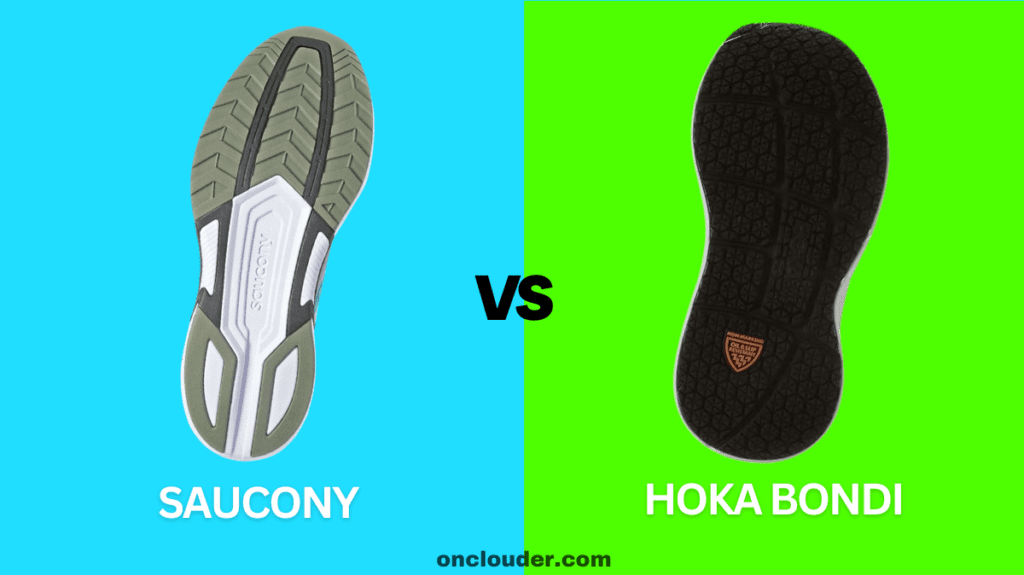
User Reviews: What Do Other Kids Think?
It’s always good to hear what other people think about these shoes. Here’s a quick look at some user reviews:
| Brand | Rating | Comments |
| Saucony | ⭐⭐⭐⭐½ | “Really comfortable and great for running!” |
| “I love how light they are.” | ||
| “They last a long time, even with lots of use.” | ||
| Hoka Bondi | ⭐⭐⭐⭐ | “So cushiony, like walking on clouds!” |
| “Took a little getting used to, but now I love them.” | ||
| “Great for long walks or standing all day.” |
Price: What’s It Going to Cost?
Of course, price is always something to think about when buying new shoes. Here’s a general idea of what you might expect to pay:
| Brand | Price Range |
| Saucony | $60 – $120 |
| Hoka Bondi | $150 – $160 |
Remember, prices can vary depending on where you buy the shoes and if there are any sales going on.
Pros and Cons
SI
please write pros and cons in table format on “Saucony vs Hoka Bondi Shoes”
Here’s a table comparing the pros and cons of Saucony and Hoka Bondi shoes:
| Aspect | Saucony | Hoka Bondi |
| Pros | – Generally more affordable – Wider range of models for different needs – Typically lighter weight – Good balance of cushioning and responsiveness – Often preferred by runners with neutral foot type | – Exceptional cushioning, especially for long distances – Very comfortable for extended wear – Good for runners with foot pain or recovering from injury – Stable ride due to wide base – Popular among heavier runners |
| Cons | – Less cushioning compared to Hoka Bondi – May not be ideal for runners needing maximum support – Some models can feel firmer underfoot | – Usually more expensive – Can feel bulky or less responsive for speed work – May feel unstable for some runners due to high stack height – Limited style options – Can be too cushioned for runners preferring more ground feel |
Conclusion
So, after all that, which shoe should you choose? Well, it really depends on what you’re looking for!
If you want a versatile shoe that’s great for lots of different activities, has a bouncy feel, and comes in lots of fun colors, Saucony might be the way to go. They’re also generally a bit less expensive.
If you’re after maximum cushioning, don’t mind a unique look, and are willing to spend a bit more, Hoka Bondi could be your perfect match. They’re especially good if you have any foot pain or if you spend a lot of time on your feet.
Frequently Asked Questions
Are Saucony or Hoka Bondi shoes better for running?
Both brands make great running shoes. Saucony might be better if you like a more traditional feel, while Hoka Bondi could be great if you want lots of cushioning.
Can kids wear Hoka Bondi shoes?
Yes! Hoka Bondi makes shoes in kids’ sizes too. Just make sure to get the right size for your feet.
How long do Saucony shoes usually last?
With normal use, many kids find that their Saucony shoes last for about a year. But this can vary depending on how often you wear them and what activities you do.
Are Hoka Bondi shoes good for walking?
Absolutely! The extra cushioning in Hoka Bondi shoes can make them very comfortable for walking, especially for long distances.
Can I wear Saucony or Hoka Bondi shoes for other sports?
While both brands are primarily known for running shoes, many of their models can work well for other activities too. Just make sure to choose a shoe that’s right for your specific sport.

